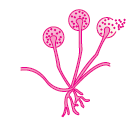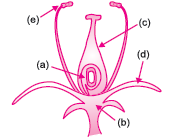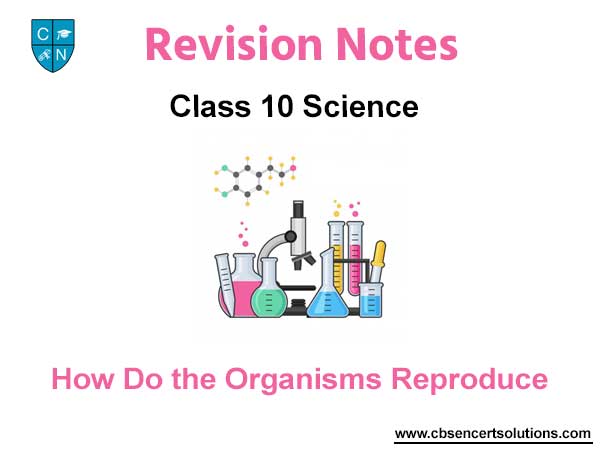Please refer to How Do the Organisms Reproduce Class 10 Science notes and questions with solutions below. These revision notes and important examination questions have been prepared based on the latest Science books for Class 10. You can go through the questions and solutions below which will help you to get better marks in your examinations.
Class 10 Science How Do the Organisms Reproduce Notes and Questions
Multiple Choice Questions
Question. ___________ is the portion on which grafting is done and it provides the roots?
(a) Stock
(b) Scion
(c) Both (a) and (b)
(d) None of these
Answer
A
Question. Which one of the options is incorrect?
Vegetative propagation is practised because
(a) Plants which produce non viable seeds can be grown.
(b) It is a easier method than sowing seeds.
(c) Such plants produce seeds and fruits much earlier than other methods
(d) For obtaining better species of plants.
Answer
C
Question. What is the surgical method of contraception in female and male respectively?
(a) Tubectomy and Vasectomy
(b) Vasectomy and Copper-T
(c) Tubectomy and Copper-T
(d) None of these
Answer
A
Question. What is the puberty age in human males?
(a) 8-10
(b) 10-12
(c) 12-14
(d) 14-16
Answer
C
Question. Which of these is not the function of the seminal vesicles present in human males?
(a) To covert the sperms in a fluid medium.
(b) To provide nutrition.
(c) To make their transport easier.
(d) To make them sticky.
Answer
D
Question. In which of the following plant bud in notches of leaves help in its propagation?
(a) Radish
(b) Bryophyllum
(c) Bougainvillea
(d) Jasmine
Answer
B
Question. The process of the transfer of pollen grains from the flower of one plant to the stigma of the flower of another plant of the same species is known as
(a) Cross pollination
(b) Fertilisation
(c) Self pollination
(d) None of the above
Answer
A
Question. Why are the testes located outside the abdominal cavity in scrotum?
(a) Because sperm formation requires more spaces.
(b) Because sperm formation requires a lower temperature.
(c) Because sperm formation requires a higher temperature.
(d) None of the above.
Answer
B
Question. The two oviducts in a human female unite into an elastic bag like structure known as
(a) Vagina
(b) Uterus
(c) Fallopian tube
(d) Cervix
Answer
B
Question. Identify the organism

(a) Rhizobium
(b) Rhizopus
(c) Rhizoid
(d) Mushroom
Answer
B
Question. The process where the unfertilised egg is released out of the body with the blood used to nourish the embryo is known as
(a) Menstruation
(b) Fertilisation
(c) Germination
(d) Pollination
Answer
A
Question. Unisexual flowers contain
(a) Both stamen and carpel
(b) Only stamen
(c) Only carpel
(d) Either stamen or carpel
Answer
D
Question. The process in which the cytoplasm of a single eukaryotic cell is divided to form two daughter cells is known as?
(a) Karyokinesis
(b) Cytokinesis
(c) Meiosis
(d) Mitosis
Answer
D
Question. Choose the correct option

| A | B | C | D | E |
| (a) Ovary | Thalamus | Filament | Sepal | Anther |
| (b) Ovary | Thalamus | Style | Sepal | Anther |
| (c) Ovule | Sepal | Style | Thalamus | Filament |
| (d) Ovule | Sepal | Style | Thalamus | Stamen |
Answer
B
Question. Vegetative propagation in potato takes place through
(a) Stem
(b) Root
(c) Leaves
(d) Seed
Answer
A
Question.Which of these life processes of an organism helps in the growth of its population?
(a)Nutrition
(b) Respiration
(c) Reproduction
(d) Excretion
Answer
C
Question. Hydra reproduces————-by—————
(a)sexually, budding
(b)sexually, regeneration
(c) asexually, budding
(d)asexually, regeneration
Answer
C
Question.Which of these is a disadvantage of vegetative reproduction?
(a)Offspring are genetically identical
(b)It is rapid and economical method of reproduction
(c)It produces seedless fruits
(d)Disease of parent plant gets transferred to the offspring.
Answer
D
Question.When an organism breaks into a number of parts and each part develop into an individual, it is called:
(a)Regeneration
(b) Budding
(c) Binary fission
(d) Spore formation
Answer
A
Question. How many chromosomes are present in a ovum of human being?
(a)29
(b)21
(c)22
(d)23
Answer
D
Question.The number of chromosomes in parents and offspring of a particular species remains constant due to—
(a)doubling of chromosomes after zygote formation
(b) halving of chromosomes during gamete formation
(c) doubling of chromosomes after gamete formation
(d) halving of chromosomes after gamete formation
Answer
B
Question.In a flower, the parts that produce male and female gametes are——–
(a)stamen and anther
(b)Filament and stigma
(c) Anther and ovary
(d) stamen and style
Answer
C
Question.In the list of organisms given below, those that does not reproduce by the asexual method are————
(a) Spirogyra
(b) dog
(c) yeast
(d) amoeba
Answer
B
Question.Which of these is not a part of male reproductive system?
(a)Scrotum
(b) Oviduct
(c) Vas-deferens
(d) Prostrate gland
Answer
B
Question.The process of development of seedling from an embryo under suitable condition is called
(a)Regeneration
(b) Pollination
(c) Germination
(d) Dormancy
Answer
C
Assertion and Reason Type Questions
Directions: In the following questions, a statement of assertion(A) is followed by a statement of reason(R).
Mark the correct choice as:
(a)Both assertion (A) and reason(R)are true and reason(R)is the correct explanation of assertion(A)
(b)Both assertion (A) and reason(R) are true but reason (R) is not the correct explanation of assertion (A)
(c)Assertion (A) is true but reason(R) is false
(d)Assertion (A) is false but reason (R)is true
Question.Assertion (A): Plasmodium reproduces by multiple fission
Reason (A): Multiple fission is a type of asexual reproduction.
Ans. Correct option (b)
Question.Assertion: Plants are vegetatively propagated even though they bear seeds
Reason(R): Potatoes reproduces through tubers, apples by cutting etc
Ans. Correct option (b)
Question.Assertion (A): In human male, testes are extra-abdominal which are present inside scrotum.
Reason(R): Scrotum has a relatively lower temperature needed for the production and storage of sperms.
Ans. Correct option (a)
Question.Assertion (A): Surgical methods are most effective methods of contraception.
Reason(R): Surgical method blocks gametes transport and hence prevent fertilization.
Ans. Correct option (a)
Very Short Answer Questions
Question.Name the following:
(a) The process in plants that links light energy with chemical energy.
Ans. Photosynthesis
(b) Organisms that can prepare their own food.
Ans. Autotrophs
(c) The cell organelle where photosynthesis occurs.
Ans. Chloroplast
(d) Cells that surround a stomatal pore.
Ans. Guard cells
(e) Organisms that cannot prepare their own food
Ans. Heterotrophs
(f) An enzyme secreted from gastric glands in stomach that acts on proteins.
Ans. Pepsin
Question. Name the correct substrates for the following enzymes.
(a)Trypsin
(b)Amylase
(c)Pepsin
(d)Lipase
Ans.(a) Trypsin-Protein
(b) Amylase-Starch
(c) Pepsin-Protein
(d) Lipase-Fats
Question. How do we know that two different individuals belong to the same species?
Ans. Members of same species are capable of interbreeding the same species by the similarity in their body design and other physical features.
Question. Give the full form of DNA.
Ans. Deoxyribo Nucleic Acid.
Question. When does copying of DNA occur?
Ans. Copying of DNA occurs during cell division.
Question. Name two plants whose flowers are unisexual.
Ans. Papaya, watermelon.
Question. What is fertilization?
Ans. Fertilization is the process of fusion of the male and the female gametes.
Question. What is the importance of DNA copying in reproduction?
Ans. DNA copying during reproduction is important for the transfer of parental characters to the offsprings.
Short Answer Type Questions
Question. What is reproduction? Lists its two types.
Ans.The production of new organism from the existing organism of the same species is called reproduction.
Types of Reproduction
(i)Asexual reproduction (ii) Sexual reproduction
Asexual Reproduction-The production of new organism from a single parent without the involvement of sex cells (gametes).
Sexual Reproduction-The process of production of new organism from two parents by making use of sex cells (gametes)
Question. Name the method by which spirogyra reproduces under favourable conditions. Is this method sexual or asexual?
Ans. Under favourable conditions spirogyra reproduces by a process known as fragmentation. This is an asexual mode of reproduction.
Question. How does Planaria reproduce? Is this method sexual or asexual?
Ans. Planaria reproduces by a process known as regeneration. It is a type of asexual reproduction.
Question. How does Plasmodium reproduce? Is this method sexual or asexual?
Ans. Plasmodium reproduces by a process known as multiple fission. Multiple fission is a type of asexual reproduction.
Question.Define vegetative propagation. List its methods and advantages.
Ans. In vegetative propagation new plants are obtained from the parts of old plants-stem, leaves or root without the help of any reproductive organ.
Natural methods of vegetative propagation

Artificial Method of Vegetative Propagation
1. Cutting
2. Layering
3. Grafting
Advantages of vegetative propagation
(i)The new plant produced by artificial vegetative propagation will be exactly like parent plant.
(ii)The fruit trees grown from cutting or grafting start to bear fruits much earlier.
(iii)Many plants can be grown from just one parent plant.
(iv)We can also get seedless plant by artificial propagation.
Question.Explain Binary Fission in Amoeba and Multiple fission in Plasmodium.
Ans. In the process of fission, a unicellular organism splits to form two or more new organisms. It is of two types.
(a)Binary fission: -In binary fission, the parent organism splits to form two new organisms.
Examples-Amoeba, Paramecium, Leishmania etc
(b)Multiple Fission: -In multiple fission the parent organism splits to form many new organisms at same time.
Example-Plasmodium
Question.How will an organism benefit if it reproduces through spores?
Ans. The reproduction by spores takes place in plants. Spores are covered by hard protective coat which enables them to survive in unfavorable conditions such as lack of food, water and extreme temperatures. When the conditions are favorable the spores can grow to produce new plants. Thus reproduction by spores’ benefits the plant because by surviving under adverse conditions, the spores make these plants live forever.
Question. State the basic requirement for sexual reproduction? Write the importance of such reproduction in nature.
Ans. Basic requirement for sexual reproduction is formation of male and female gametes, fusion of gametes.
Importance
Combination of DNA from two different individuals leads to increase in genetic variation in the organism.
This leads to diversity in the population which helps in natural selection.
Question. List any four steps involved in sexual reproduction and write its two advantages.
Ans. Steps of Sexual Reproduction
* Formation of male and female gametes.
* Transfer of male gamete to female gamete.
* Fusion of gametes resulting in zygote formation.
* Zygote grows into an embryo forming a new individual.
Advantages:
* Increase genetic variation
* Plays an important role in the origin of new species.
Question.Reproduction is one of the most important characteristics of living beings. Give three reasons in support of the statement.
Ans. (i) For continuation of species
(ii)It promotes diversity in characters
(iii)Enhance the survival chances
Question. Draw a labeled diagram of a human male reproductive system.
Ans.

Long Answer Type Questions
Question. Define pollination. Explain the different types of pollination. List two agents of pollination. How suitable pollination does leads to fertilization?
Ans. Pollination: -Transfer of pollen from anther to stigma of the flower.
Types of pollination:
(a) Self Pollination: Transfer of pollen from anther to stigma occurs in the same flower.

(b) Cross Pollination: Pollen is transferred from anther of one flower to stigma of another flower.

Agents of pollination: Wind, Water, Insects and Animals
A tube grows out of the pollen grain and travels through the style, to reach the female germ cell in the ovary to cause fertilization.
Question. (a) Draw a neat diagram of female reproductive system of human being and label the following
(i) Parts where eggs are formed
(ii) Site of fertilization
(iii) Place of implantation
(iv) Place for entry of sperm
(b)What is contraception? List three advantages of adopting contraceptive measures.
Ans (a)

(b)Contraception is the methods or ways to prevent fertilization and pregnancy in fertile females.
Three major advantages of adopting contraceptive measures are as follows:
(i)Help in family planning and population control.
(ii)Prevention of sexually transmitted diseases like gonorrhea, HIV-AIDS etc.
(iii)Prevention of unwanted pregnancies.
Question. (a) Write the function of following parts in human female reproduction system:
(i)Ovary (ii) Oviduct (iii) Uterus
(b)Describe in brief the structure and function of placenta.
Ans (a) (i)Ovary: Release egg and female hormone estrogen
(ii)Oviduct: Transportation of ovum from ovary to uterus and it is a site of fertilization.
(iii)Uterus: Development of embryo
(b)Placenta: It is a disc embedded in uterine wall which contains villi on the embryo side of the tissue and blood space on mother side.
Function of placenta:
(i) Provides nourishment to embryo from mother’s blood.
(ii) Removal of waste embryo to mother’s blood.
Question.(a)Draw a well labeled diagram to show the process of fertilization in flowering plant.
(b)Explain the process of double fertilization in angiosperm plant.
Ans (a)

(b) Double Fertilization– It occurs when one male nucleus fuses with egg cell to form zygote and other male nucleus fuse with two polar nuclei.

We hope the above How Do the Organisms Reproduce Class 10 Science are useful for you. If you have any questions then post them in the comments section below. Our teachers will provide you an answer. Also refer to MCQ Questions for Class 10 Science


